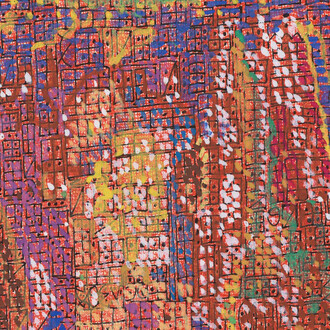Kalfayan Galleries is pleased to present Mother tongue the first solo exhibition in Greece by Harm Gerdes (born in 1994 in Darmstadt, Germany). The opening has taken place on Thursday, 8th May 2025. The exhibition is the artist’s fifth solo exhibition overall, after Gerdes graduated from the Düsseldorf Kunstakademie in 2020. He currently lives and works in Athens.
I want each of my works to be a character – and to have character.
(Harm Gerdes)
Is intuition the “mother tongue” of painting?
Although the title of this show—Mother tongue—initially evokes the artist’s mother tongue, it simultaneously refers to his profound engagement with the act of painting, which lies at the core of his identity. As he notes: “My work is an exploration of how I perceive certain things. I can simply observe how people interact with each other. I can observe what’s happening within relationships—observe power games, offerings, love, hate—but also deeper psychological and philosophical questions about human nature, and most importantly, how I experience all of it and how I reflect on it.”
One must experience Harm Gerdes’ works in person to fully appreciate that what may appear from a distance—or on-screen—as a digital composition, are in fact abstract painterly constructions on canvas. Vibrant fields of colour, organic forms, tangible materiality, and fluid motion all interacting dynamically creating the image.
This ambiguity, the oscillation between virtual aesthetics and the physical world, reflects the transitions we all experience daily between physical and digital realms. Yet, this passage corresponds only to the first reading – to the artwork’s invitation. The details, revealed through a persistent gaze, express something more metaphysical and personal.
Although Mother tongue unfolds through references to previous bodies of work, it also marks a new phase in the artist’s practice: one liberated from the urgency of referenciality, allowing the painting process itself to guide the emergence of the image freely and intuitively.
In a deliberate and demanding artistic choice, Gerdes refrains from anchoring his work in a specific narrative—eschewing storytelling that might otherwise narrow the viewer’s reading to a more limited interpretation. Yet, a closer look reveals recurring motifs and central concerns that subtly permeate the work.
The artist fuses contemporary aesthetics with fundamental questions that have preoccupied painting throughout its history. The spaces that emerge from the layering of forms, the (serious) play between the notions of hierarchy and freedom, the moments of intimate familiarity in certain “neighbourhoods” within the paintings and the sudden transcendence of the familiar through unexpected transformation, the challenge of coexistence, and the rhythmic construction and deconstruction of compositional balance; all of these persistently address the nature of the pictorial image—its creation and perception—while eliciting an instinctive aesthetic pleasure.
Although Gerdes’ work is technically accomplished and striking —even sometimes almost “mathematically” structured—it relies on intuition. He describes the layers, overlays, and complex relationships of forms in his work as an “archaeology of colour.” Within this framework, we can also perceive the impact of his daily experiences— such as Athens and Greece, where he moved in September 2022 and where he created the works on view. His choice of colours sometimes evokes the simplicity of the Greek summer (the artist has recently been reading Elytis) and at other times reflects the dense urban fabric he experiences in his everyday life.
The title of a work may also function similarly: the piece Hommage to Elizabeth, for example, refers both to the name of his mother and to Elizabeth Murray, whose work has been a source of inspiration for the artist. Images within images offer yet another way to read his work; in this piece, we can discern his interpretation of a familiar motif by Gerhard Richter – also a painter from the School of Düsseldorf– whom Gerdes references when discussing the authenticity of the painted image.
Finally, the sense of joy that characterizes Gerdes’ work resonates both with the pleasant feeling we experience when hearing our mother tongue – and the valuable sense of belonging, especially for those of us with more than one homeland – and with the joy of discovery, the unforeseen resolution, and the aesthetic provocation that a compelling image can create.
(Text by Sofia Eliza Bouratsis, art theorist and curator, National Gallery. Alexandros Soutsos Museum)
















